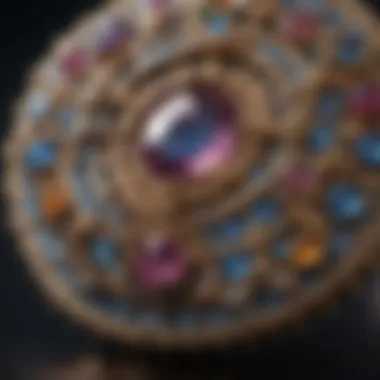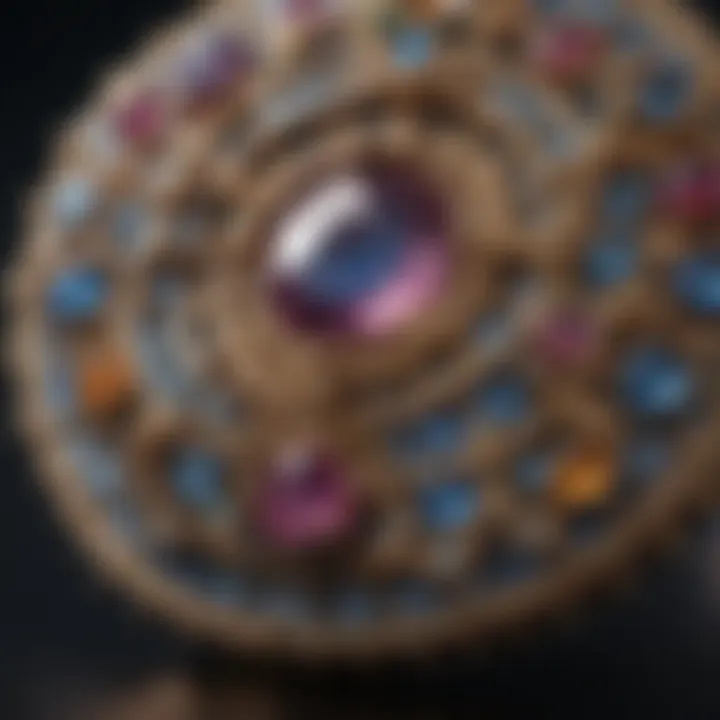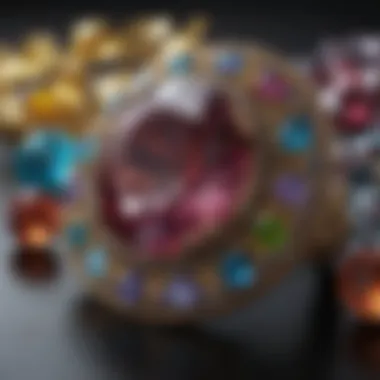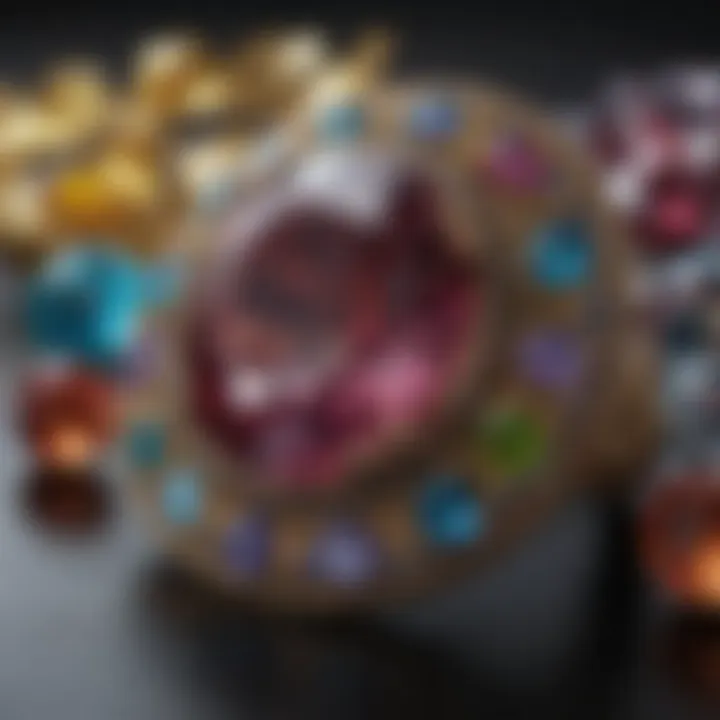The Significance of Stones in Jewelry Crafting


Intro
The world of jewelry is often painted in hues of gold and silver, yet the true essence lies within the stones that adorn these pieces. Gemstones have a story, a personality, and a significance that transcends mere decoration. They carry whispers of history, intricacies of artistry, and layers of cultural meaning. As we journey through the realm of gemstones, we will uncover not just their physical beauty, but also what they represent and how they have shaped our societies.
Gemstone Overview
Definition of Gemstones
Gemstones, in simplest terms, are precious or semi-precious stones that are cut and polished for use in jewelry. They are typically minerals that possess beauty, durability, and rarity. However, the definition extends beyond these characteristics; it encompasses a myriad of materials such as organic gems like pearls and amber. Each stone, from the deep blue of sapphire to the fiery red of garnet, carries its own allure and charm.
Classification of Gemstones
Classification of gemstones is essential to understand their unique properties and values. They generally fall into two main categories: precious and semi-precious stones. Precious stones like diamonds, rubies, sapphires, and emeralds are often sought after for their rarity and beauty. On the other hand, semi-precious stones include a wide range of gems such as amethyst, topaz, and turquoise.
A closer look at classification:
- Precious Stones
- Semi-Precious Stones
- Organic Gems
- Diamonds
- Emeralds
- Rubies
- Sapphires
- Amethyst
- Garnet
- Opal
- Citrine
- Pearls
- Amber
Understanding this classification not only helps in selecting stones but also in appreciating their value and rarity.
Historical Significance
Origins of Gemstone Use
The allure of gemstones can be traced back thousands of years. The earliest known use of gemstones in jewelry dates to ancient civilizations, where they were highly prized for their beauty and believed to possess magical powers. In ancient Egypt, turquoise and lapis lazuli adorned the jewelry of pharaohs, while the Mesopotamians carved complex designs on carnelian.
"Stones often were seen as a bridge between the physical and spiritual worlds, used to convey authority and protect against evil."
Cultural Insights: Gemstones in Ancient Civilizations
Different cultures have attributed distinct meanings and values to various gemstones. The Romans believed that certain stones could safeguard against harm. For instance, amulets of garnet were worn by warriors to symbolize protection in battle. Similarly, ancient Greeks valued the clarity of crystal quartz, believing it had the power to elevate the spirit.
Gemstones have also played significant roles in religious practices; for example, the Twelve Tribes of Israel each had a stone representing them, symbolizing their unique characteristics and roles within the community.
As we peel back the layers of history, we begin to see that these stones are more than mere baubles; they hold the stories of people, cultures, and eras long past.
Prolusion to Stones in Jewelry
The realm of jewelry is not merely about aesthetic allure; it's a tapestry woven with history, culture, and craftsmanship. Stones play a pivotal role in this narrative, acting as the very essence that brings pieces to life. From ancient adornments crafted from simple pebbles to the exquisite diamond-studded creations that captivate modern audiences, the journey of stones in jewelry transcends time and space. Understanding the role of stones is essential for both collectors and designers alike, as it unveils the intricacies that differentiate a mere accessory from a cherished heirloom.
The selection of stones goes beyond their visual appeal. Factors such as hardness, clarity, and cultural symbolism are crucial for anyone who wishes to comprehend the true value and significance of these gems. Moreover, the historical context of stones encapsulates the evolution of craftsmanship and style, making it a fascinating angle to explore. This article will delve deeply into how these natural wonders have come to represent emotions, milestones, and aspirations throughout humanity's timeline.
Historical Context
The historical significance of stones in jewelry can be traced back to ancient civilizations. For instance, the Egyptians are famous for their use of lapis lazuli, turquoise, and carnelian in their jewelry, representing wealth and spirituality. They believed that certain stones held magical powers, and their use in funerary artifacts was intended to protect the deceased in the afterlife.
In contrast, cultures such as the Romans and Greeks adorned themselves with opulent gemstones, signaling status and power. Take the Roman Empire, where it was not uncommon for the elite to sport large engraved gems as both jewelry and signet rings, often used to seal important documents. This intersection of utility and adornment showcases how stones were integrated into daily life, reflecting societal values of the time.
As centuries passed, gemstones went beyond mere decoration; they evolved into symbols woven into the fabric of societal norms, marital traditions, and personal identity. The engagement ring, for example, has historical roots dating back to the Middle Ages when diamonds were believed to symbolize an unbreakable bond. Today, this tradition persists, with diamonds representing eternal love.
Cultural Significance
Cultural significance plays a hefty role in the understanding of gemstones. Each stone bears unique meanings that vary significantly across cultures. For example, in many Native American traditions, turquoise is revered as a sacred stone believed to foster healing and provide protection. It can often be found in ceremonial jewelry, emphasized for its spiritual significance.
In contrast, consider the deep cultural attachment to jade in East Asian societies. It symbolizes purity and moral integrity, often presented as a gift during significant life events such as weddings or births. The status of jade is not just superficial; it extends to familial and societal structures where it symbolizes both respect and legacy.
"Jade is not merely a stone; it is a vessel of our culture's identity, endlessly molded through traditions and stories."
Additionally, the usage of gemstones in traditional medicine practices, such as the belief that amethyst can calm the mind and enhance intuition, illustrates the diverse ways cultures engage with the natural world.
In summary, stones represent a blend of beauty and complexity within the jewelry realm, bridging the gap between craftsmanship, historical narratives, and cultural values. Through this exploration, we lay a foundation to appreciate not just the surface beauty of gemstones but their place in the larger mosaic of human expression.
Classification of Gemstones
When it comes to understanding gemstones, classifying them is not just a simple categorization exercise; it plays a crucial role in appreciating their value, rarity, and uses in the jewelry industry. A well-rounded grasp of gemstone classification offers several advantages. It guides both collectors and jewelers about what to expect concerning quality, origin, and appropriate care. Plus, it aids in recognizing the differences in price points, which can help one make informed decisions whether they’re buying a piece of jewelry or selecting stones for crafting.
Precious vs. Semi-Precious Stones
In the world of gemstones, the terminology can be somewhat misleading. The distinction between precious and semi-precious stones may lead some to think that precious stones are inherently superior. Traditionally, diamonds, rubies, sapphires, and emeralds fall into the precious category. These gems are often coveted for their clarity, durability, and the vibrancy of their color. On the other hand, semi-precious stones like amethyst, topaz, garnet, and turquoise are viewed as less prestigious, yet they can be equally striking and valuable.
Here are a few key points that clarify the differences:
- Market Demand: Precious stones typically have a higher market demand, owing to their rarity and historical significance. This translates to higher price tags.
- Durability: Precious stones like diamonds score a 10 on the Mohs hardness scale, making them the toughest of the bunch, while some semi-precious stones, like opal, can be softer and more prone to scratching.
- Color Play: Some people prefer semi-precious stones for their unique colors and patterns, which might be more diverse and playful compared to the classic hues of precious stones.
In summary, the distinction boils down to market perception rather than a definitive quality measure; sometimes a semi-precious stone can steal the show, even wearing the crown of a precious counterpart.
Natural, Synthetic, and Simulant Stones
Gemstones are not all created equal. Understanding the differences between natural, synthetic, and simulant stones can significantly influence purchasing choices, as well as expectations regarding their uses in jewelry.
- Natural Stones are formed by geological processes over millions of years. They are harvested directly from the earth and retain their natural beauty, flaws and all.
- Synthetic Stones, on the other hand, are lab-created and have the same physical and chemical properties as their natural counterparts. They are often produced with the intention of replicating the beauty of natural gemstones, but without the flaws. A perfect example of synthetic stones would be lab-created sapphires or rubies, which have become increasingly popular due to their lower price point.
- Simulants, such as cubic zirconia, are designed to imitate the appearance of natural gemstones without having the same chemical structure or geological origins. While they might look stunning and attractively priced, they don’t hold the same value as genuine stones.


Choosing the right type of stone is often a matter of personal preference, budget considerations, and intended use. A collector might have a hankering for natural gems to appreciate their authenticity, while a jewelry designer might lean towards synthetics for practical reasons and creative freedom.
Ultimately, the classification of gemstones goes beyond definitions. It’s about understanding their roles, characteristics, and how they resonate with our aesthetic and emotional values in the grand tapestry of jewelry creation.
Popular Stones Used in Jewelry
The world of jewelry is profoundly influenced by the types of stones used in crafting these pieces. Each stone carries its own story and significance, making them not just decorative but also meaningful. The popularity of certain stones is not merely based on their beauty; these gems often represent emotions, cultural heritage, and even prosperity. A deeper look into these popular stones reveals their unique attributes, appeals, and considerations that can significantly enhance one's jewelry collection or design.
Diamond: A Timeless Symbol
Diamonds have long been hailed as the epitome of luxury and prestige. Commonly associated with love, they are often chosen for engagement rings, symbolizing eternity and strength. The clarity, color, cut, and carat weight are essential factors in evaluating a diamond's worth. Historically, diamonds were believed to possess magical properties, providing strength and invincibility to its wearer.
- Quality Factors:
- Cut: Creates the sparkle and reflects light beautifully.
- Clarity: Indicates the presence of internal or external flaws.
- Color: The most desirable diamonds are colorless, though colored diamonds have gained attention for their uniqueness.
"A diamond is a chunk of coal that did well under pressure."
This phrase captures the mystique and hidden beauty of diamonds that emerge over time and mastery.
Emerald: The Stone of Renewal
Emeralds are cherished for their vibrant green hue, representing rebirth and renewal. Many believe that these stones bring protection, healing, and harmony. Often referred to as the stone of the heart, emeralds are linked to love and compassion. They can also be a bit tricky when it comes to quality; inclusions are often more visible and common in emeralds than in other stones.
- Noteworthy Attributes:
- Color: A rich green color with slight bluish hues is most sought after.
- Clarity: Natural inclusions are expected and often add to an emerald’s charm.
Sapphire: Beyond the Blue
While blue sapphire often steals the spotlight, this stone comes in a rainbow of colors, each with its own meaning. Sapphires symbolize wisdom and nobility, often desired for their durability and rich colors. Many cultures believe that wearing sapphire pendants promote clarity of thought and protection.
- Color Varieties:
- Blue: Most renowned, often associated with royalty.
- Pink: Gains popularity as a bold choice for engagement rings.
- Yellow and Green: Unique options for those looking for something different.
Ruby: The King of Gemstones
Rubies are synonymous with passion and power. Their vibrant red color signifies love, making them a frequent choice in wedding jewelry. Because of their hardness, rubies are an exceptional choice for everyday wear. They are not just beautiful; their deep colors can stir emotions and symbolize vitality and passion.
- Key Qualities:
- Color: The more vivid the red, the more valuable the ruby.
- Symbolism: Representing love, vitality, and energy.
Other Notable Stones: Garnet, Amethyst, Topaz
Several other gemstones deserve recognition for their beauty and significance in jewelry making.
- Garnet: Recognized for its deep red tone and varied types, garnet represents love and loyalty.
- Amethyst: Known for its violet hue, this stone is often seen as a purifying crystal, believed to promote tranquility and inner strength.
- Topaz: Available in a range of colors, topaz is popular for its affordability and beauty, making it an excellent choice for those new to collecting gems.
These gems not only add beauty to jewelry but also carry with them rich stories and symbolism, making them treasured pieces in anyone's collection.
Physical Properties of Gemstones
Understanding the physical properties of gemstones is paramount in the world of jewelry. This knowledge not only determines the aesthetic appeal of gems but also their practicality and overall value. Each gemstone carries unique characteristics that give it a distinct identity, affecting choices in both design and use. This section will dive into the significant aspects of hardness and durability, color and clarity, as well as luster and transparency, painting a full picture of how these factors influence the gemstone industry.
Hardness and Durability
Gemstone hardness is often the first consideration when evaluating a stone's suitability for jewelry. The Mohs scale, a system that ranks minerals based on their ability to scratch one another, is employed in this assessment. For instance, a diamond, with a hardness of 10, can scratch almost any other mineral, making it an ideal choice for pieces that endure everyday wear.
In contrast, softer stones like turquoise or opal hold a hardness rating of just 5 to 6, meaning they might be more prone to damage. Here are some implications of hardness and durability in gemstones:
- Wearability: The harder the stone, the more suitable it is for frequently worn jewelry, such as rings and bracelets.
- Maintenance: Softer stones require more care and cautious handling to prevent scratches or chips.
- Resale Value: Hardness can influence a stone's desirability in the market. Harder stones often come with a higher price tag due to their durability.
"In the jewelry world, a gem’s hardness often makes the difference between a cherished heirloom and a fragile trinket."
Color and Clarity
Gemstones are like nature’s palette; their colors can evoke emotions and draw the eye. However, the vibrancy of a stone is not merely a superficial quality. Color and clarity are closely interlinked, as inclusions or impurities can significantly alter the stone's perceived value. Here’s how they play a role:
- Color: Different stones exhibit various hues, which can be influenced by factors like crystal structure and mineral content. For instance, sapphires are typically blue but can occur in a spectrum of colors based on the trace elements present.
- Clarity: This refers to the absence of inclusions and blemishes in the stone. Higher clarity generally results in a more desirable and valuable gemstone. Unlike diamonds, some stones, like jade or lapis lazuli, are valued for their unique inclusions, which tell a story of their formation.
- Value Determination: Both color saturation and clarity directly impact the rarity and price of gemstones. A deep, well-saturated blue sapphire with minimal inclusions will command a higher price compared to a paler, flawed version.
Luster and Transparency
Luster serves as the gem's shiny factor—how light interacts with a stone’s surface offers another layer of character. It varies widely among different gems:
- Types of Luster: Generally categorized as metallic, adamantine, vitreous, or dull, depending on how shiny the surface appears. For example, diamonds exhibit an adamantine luster, causing them to sparkle, while stones like jade possess a more vitreous sheen.
- Transparency: This term defines how light passes through a gemstone. Some stones, like aquamarine, are transparent and showcase clarity, while others like opal may be more opaque and diffuse light. Both characteristics add to the aesthetic appeal and integrity of the gem.
By recognizing the significance of luster and transparency, jewelry designers can make informed decisions about which stones to use in their creations, enhancing their work’s overall beauty and impact.
Ultimately, the physical properties of gemstones not only affect their visual allure but also influence how they are perceived in the market. By understanding these parameters, collectors, jewelers, and enthusiasts alike can appreciate the inherent qualities that make each gemstone unique.
Treatments and Enhancements
When we talk about gemstones and their role in jewelry, it’s crucial to highlight the significance of proper treatments and enhancements. These processes help improve the appearance and durability of the stones, thereby increasing their allure and value. While natural beauty holds undeniable charm, many gems undergo treatments to reach their full potential, enabling jewelry designers to use them in extraordinary ways. Understanding these techniques enhances not only appreciation for gemstones but also assures buyers that the piece they invest in holds its worth.


Heat Treatment
Heat treatment is one of the most common methods of enhancing gemstones. This process involves exposing the stones to high temperatures to alter their color or clarity. For example, many sapphires and rubies have their vivid blue or red hues intensified through this technique. The practice doesn't stop with just improving aesthetics; it can also enhance stability, minimizing the risk of future damage due to environmental factors.
While most of the time, heat treatment is a benign process, the consumer should be in the know. It’s essential to inquire about whether the stone has been treated. Quite simply, transparency can lead to trust. When you’re eyeing that stunning sapphire, knowing the story behind it can enhance its perceived value.
Dyeing and Coating Techniques
Another avenue of enhancement is through dyeing and coating methods. Take turquoise, for instance. This stone, admired for its rich hues, often undergoes treatment to alter or improve its color. By dyeing, more vibrant shades can be manufactured, allowing more artistic freedom in jewelry design. However, caution is advised. Such treatments can sometimes be misleading, making a semi-precious stone appear more valuable than its true nature.
Coating is another technique, where a thin layer of substance is applied to alter surface appearance. This could bring out shine or depth, enhancing the stone's overall aesthetic. While these methods can be appealing, understanding their implications is vital. Potential buyers need to differentiate between natural beauty and forced beauty because it can affect both resale value and personal satisfaction in a collection.
Synthetic Processes
In contemporary jewelry, synthetic gems have found their seat at the table. Created to mimic the properties of natural stones, synthetic gemstones can achieve the same physical and chemical characteristics through human intervention. This doesn’t mean they hold any less allure. For instance, stunning synthetic diamonds boast the same brilliance as their natural counterparts, but tend to be significantly more affordable.
While they can provide an eco-friendly option for those concerned about mining impacts, perceptions around authenticity often raise questions. Collectors and enthusiasts need to consider whether they prioritize natural origins or appreciate the brilliance that lab-created gems can offer.
In summary, treatments and enhancements are an integral part of the gemstone narrative. Knowing the processes behind each gem adds layers of context and meaning, further enriching their appeal. Just as every stone has a unique story, so too do the enhancements they undergo, weaving together tradition, technology, and a touch of artistry in the world of jewelry.
"Understanding the treatments and enhancements of gemstones is just as important as knowing their natural characteristics. It allows collectors a fuller perspective on their value and purpose in jewelry."
Keywords: heat treatment, dyeing techniques, synthetic gemstones, gemstone enhancement, jewelry design
By diving into these treatments, one not only appreciates the breathtaking elements of jewelry but also makes informed decisions, whether purchasing for oneself or a treasured collection.
The Crafting Process
The crafting process of gemstones is like a dance between nature and human creativity, transforming raw stones into stunning pieces of jewelry. This phase is crucial not only for aesthetic reasons but also for enhancing the intrinsic values of the stones. Understanding this process uncovers how the beauty we admire in gems is meticulously honed through skill and artistry.
The journey a stone takes is both fascinating and complex, encompassing various stages including extraction, cutting, polishing, and setting. Each stage requires a distinct set of skills and a profound knowledge of the characteristics of the stone being worked on. Moreover, it’s about respecting the natural beauty within the stone while also making decisions that amplify its appeal.
From Rough Stone to Gem
Transforming a rough stone into a polished gem is no small feat. Initially, the stone is evaluated to determine its quality and potential. This assessment dictates how much care will be needed during the crafting process, as well as influencing decisions on how to cut the stone. Craftsmen consider factors like inclusions, color zoning, and overall size.
Once the evaluation is complete, they begin the cutting process. This is where artistry meets precision. Skilled gem cutters employ various techniques such as faceting—a method that involves cutting triangular facets to reflect light and create brilliance. The aim is to minimize waste while highlighting the best features of that gem.
A rough diamond, for instance, might first be cleaved before being shaped into a perfect brilliant cut; meanwhile, an emerald may require a different approach due to its brittle nature. The journey from rough stone to gem often looks like this:
- Selection: Choosing the right stone with the most potential.
- Cutting: Shaping the stone while being mindful of its durability.
- Polishing: Bringing out the shine and beauty of the stone through careful buffing.
"Every gemstone tells a story; the craftsperson is simply the narrator, weaving the narrative from rough to refined."
Design and Setting
Once the gemstone is shaped to perfection, the next step is designing and setting it into a piece of jewelry. This is where imaginative ideas come to life. Jewelers closely collaborate with designers to craft a piece that complements the stone's characteristics while also aligning with contemporary trends or timeless styles.
The choice of metal can greatly influence the overall aesthetics of the jewelry. For example, yellow gold often adds warmth, making colorful stones pop, while white gold or platinum can accentuate the clarity of diamonds and larger gemstones. It's not just about slapping a stone onto a metal base; it’s about creating a harmonious blend.
Additionally, several setting styles come into play:
- Prong setting: Offers maximum light exposure, ideal for diamonds.
- Bezel setting: Provides a modern, sleek look that securely holds the stone.
- Pavé setting: Envelops the piece in tiny stones, giving a continuous sparkle.
Each design decision carries weight, as it not only influences beauty but also functionality. The way a stone is set can affect its security and wearability in everyday life. By marrying design with technical craftsmanship, the final jewelry piece becomes more than an accessory; it turns into an artful expression of personal style and sentiment.
Metaphysical Properties of Gemstones
In the realm of jewelry and stones, metaphysical properties hold a prominent position that entices gemstone enthusiasts and collectors alike. Beyond their physical beauty and aesthetic allure, many stones are believed to embody various energies and attributes that can influence the wearer’s life. Understanding these properties allows individuals to not only appreciate their jewelry visually but also to engage with the deeper meanings attributed to each gem.
Healing Properties
The healing properties of gemstones have been a topic of interest for centuries. People often turn to these stones for their purported ability to heal both physical ailments and emotional troubles. For example, amethyst is widely cherished for its calming effects, assisting in stress relief and promoting restful sleep. Likewise, the rose quartz is often dubbed the stone of love, believed to foster compassion and emotional healing.
Some gemstone enthusiasts argue that it's not merely superstition, but that the vibrational frequencies of these stones can resonate with the human body. This connection might aid in balancing energies and fostering well-being. While scientific backing on these claims may be scarce, the anecdotal evidence and personal experiences shared by users cannot be dismissed entirely.
"Gemstones are the silent allies of our emotional and spiritual journeys, acting as a light in periods of darkness."
Healing rituals often incorporate laying specific stones on particular chakra points, promoting energy flow and harmony within the body. Gathering a collection of stones based on individual needs—say, black tourmaline for grounding or citrine for abundance—can create a personalized toolkit for enhancing one’s energy.
Spiritual Significance
Dipping into spiritual significance, gemstones resonate deeply with those seeking a connection to something beyond the material world. Each stone's properties are steeped in history and lore, often associated with specific cultures or ancient beliefs. For instance, lapis lazuli has been revered since antiquity in countries like Egypt, believed to connect the wearer to higher knowledge and wisdom. In similar vein, turquoise has been considered a protective talisman, fostering a sense of safety and stability.
Many spiritual practices revolve around these stones, using them in meditation, manifestation, and rituals. Some practitioners find that carrying specific stones or wearing them as jewelry during meditation enhances their ability to focus and connect with spiritual guides or their inner selves. The unique hues and textures also play into the cultivation of mindfulness and appreciation in spiritual practices.
Incorporating gemstones into your spirituality can take many forms:
- Meditation: Using a stone while meditating to deepen focus.
- Rituals: Creating crystal grids for intention setting or energy work.
- Mantras: Speaking affirmations while holding specific stones to enhance their effects.
The exploration of metaphysical properties beckons gemstone enthusiasts to look beyond the surface, encouraging a journey through history and personal discovery that resonates with many facets of life. By understanding the healing powers and spiritual significances attributed to gems, one can cultivate a deeper relationship with the stones they cherish.
Trends in Gemstone Jewelry
The trends in gemstone jewelry reflect not just aesthetic preferences but also deeper cultural shifts and technological advancements in society. This section sheds light on the dynamic changes observed in the world of gem-studded adornments. The significance of tracking these trends lies in understanding consumer behaviors and the market's direction, which in turn aids jewelers, collectors, and enthusiasts in making wise choices—whether for personal wear or investment.


Emerging Styles
Gemstone jewelry has evolved dramatically in the past few years. Increasingly, jewelry designers are leaning towards bold, unique pieces over traditional styles. This is evident in rising preferences for asymmetrical designs and geometric shapes that break away from the cookie-cutter mold.
Building a collection today often means chasing after not just rare gems but also those wrapped in a narrative. Here are some noteworthy emerging styles:
- Layering and Stacking: Wearing multiple pieces together allows for a personalized touch. Layering necklaces of various lengths and mixing rings with different stones for a curated look is becoming more favoured.
- Birthstone Customization: Personalized jewelry like birthstone rings or necklaces is gaining traction. Individuals are keen to express their identity, highlighting personal birth months or special dates through thoughtfully curated stones.
- Sustainable Choices: Eco-conscious consumers are increasingly seeking out ethical gemstones. Whether lab-grown alternatives or recycled materials, trends point towards a collective desire to minimize impact and maximize sustainability in the jewelry-making process.
- Messy Aesthetics: The trend moves away from highly polished looks towards a more organic presentation. Rough, unpolished stones or imperfect settings become a reflection of nature’s beauty, appealing to those drawn by authenticity.
These styles not only cater to superficial beauty but also resonate with deeper meanings.
The Influence of Social Media
In today’s digital age, social media platforms have become powerful game-changers in the gemstone jewelry market. Instagram, Pinterest, and TikTok, for example, act as broad canvases where trends are painted swiftly and vividly.
In fact, influencers and celebrities play pivotal roles in shaping public tastes. For instance, when a well-known personality showcases a distinctive gemstone ring, it can spark a surge in demand that was previously dormant.
A few key points about this influence include:
- Visual Impact: The stunning visuals shared on these platforms promote desirability. Posts showcasing real-life wear, versus flat images in catalogs, allow consumers to envision these gemstones as part of their daily lives.
- Bespoke Influence: More niche markets have sprouted due to social media forums. Crowdsourcing ideas on platforms like Reddit or Facebook groups can lead to greater demand for personalized pieces that might have been regarded as less mainstream previously.
- Global Reach: Trends can begin in local settings but can rapidly spread around the globe. A trend observed in Tokyo can be in vogue in New York within weeks thanks to social media’s expansive reach.
Given these facets, gemstone enthusiasts, collectors, and designers must keep a keen eye on the social media landscape. The evolving trends offer not only insight into current market values but also signal what might be valued tomorrow.
"Trend forecasting is more than just watching what's hot right now. It's about understanding consumer psychology and predicting where tastes will evolve."
To navigate future purchases or designs, staying attuned to these trends is invaluable. The intersection of gemstone appeal and societal influences creates a vibrant tapestry in the ever-changing jewelry landscape.
Care and Maintenance of Jewelry Stones
The longevity and allure of jewelry stones greatly depend on how they are cared for and maintained. Just like a vintage car needs regular tune-ups to keep it running smoothly, gemstones require specific attention to ensure they retain their beauty and value over time. Understanding the nuances of care not only protects one’s investment but also enhances the experience of owning these precious items.
Proper maintenance helps prevent damage from environmental factors, wear and tear, and even everyday mishaps. Over time, neglect can dull the sparkle of a diamond or cloud the transparency of an emerald, detracting from its initial charm. Moreover, regular upkeep can highlight the stone’s unique properties and ensure that each piece continues to bring joy.
Cleaning Techniques
Keeping jewelry gems pristine involves regular cleaning, but it’s crucial to choose the right methods tailored to the specific type of stone. Here are a few methods to consider:
- Mild Soap and Water: For most gemstones, a gentle solution of mild soap and warm water is quite sufficient. Soak the piece for a few minutes, then gently scrub with a soft brush, like a toothbrush. Rinse thoroughly and dry with a microfiber cloth to avoid scratching.
- Ultrasonic Cleaners: These machines can do wonders, especially for stones that are durable, like diamonds and sapphires. However, caution should be exercised as some gems, such as opals or pearls, might get damaged in these machines. Always check compatibility before proceeding.
- Professional Cleaning: For heirloom or particularly valuable pieces, it’s best to consult a professional jeweler for cleaning services. They have the expertise and tools to clean the stone effectively without risking any damage.
"A stitch in time saves nine" – Regular cleaning and maintenance can save your gems from extensive wear down the line.
Storage Solutions
How one stores their jewelry can significantly impact its condition. Storing gemstones properly not only safeguards them from scratches and other forms of damage but also allows you to appreciate their beauty every time you open your jewelry box.
Here are some effective strategies for storing jewelry stones:
- Individual Compartments: Use a jewelry box with separate compartments for each piece. This prevents friction and scratching that can happen when stones rub against each other.
- Soft Linings: Ensure the box has soft fabric, like velvet or felt, which protects the stones from physical contact with hard surfaces that could cause chips.
- Temperature and Humidity Control: Keep your jewelry in a stable environment, away from extreme temperatures and high humidity. Fluctuations can adversely affect certain stones, particularly organic ones like pearls and coral.
- Avoiding Direct Sunlight: Some gemstones can fade or discolor when exposed to direct sunlight for prolonged periods. Store them in a dark location to maintain their vibrancy.
- Watches and Loose Stones: For watches or loose stones, consider individual pouches or soft bags to keep them secure and protected, especially during travel.
Ensuring the right care and maintenance can turn your gemstone collection from ordinary to extraordinary, keeping your cherished pieces sparkling for many years to come. By understanding the cleaning techniques and optimal storage solutions, you foster a deeper appreciation for the art and science behind these beautiful stones.
Collecting Gemstones: A Personal Journey
Collecting gemstones can feel like embarking on a treasure hunt. It’s a personal odyssey that draws enthusiasts into the depths of geology, aesthetics, and even history. Each stone tells its own unique tale, often intertwined with personal memories and experiences. But there’s more to this pursuit than simple admiration; the art and science of collecting gemstones opens avenues for both joy and knowledge.
Building a Collection
Creating a gemstone collection is both an art and a science, requiring a keen eye for quality, color, and unique characteristics. It’s not merely about amassing stones; it’s about curating a treasure trove that reflects personal tastes and values.
- Understand Your Preferences: One way to build a collection is to first identify what captivates you. Do you prefer vibrant colors, like those in tourmaline, or perhaps the subtle beauty of opals?
- Focus on Quality Over Quantity: It is tempting to gather as many pieces as possible, but prioritizing quality helps ensure that each stone holds value, both sentimental and monetary. A well-cut diamond or a rare piece of kunzite can be far more rewarding than a full box of lesser-quality stones.
- Learn the Marketplace: Familiarize yourself with gemstone dealers, trade shows, and online communities. Knowledge of where to buy can lead to finding rare gems not often seen in typical markets. Websites like reddit.com can connect you with fellow enthusiasts sharing their experiences.
- Document Your Gems: Consider keeping a record of your collection. Detailed notes on each stone’s origin, cut, and any unique stories can enhance your personal journey. It’s like holding onto a piece of history that only you can narrate.
Building a collection not only nurtures a passion for beauty but also cultivates a deeper appreciation for the natural world.
Investment Considerations
Gemstones often represent a dual value: intrinsic beauty and potential monetary worth. As with any investment, careful consideration is key. Here's what to ponder:
- Market Trends: Just as stocks fluctuate, so do the prices and desirability of gemstones. Keeping an eye on industry trends helps collectors forecast which stones might increase in demand. For instance, the rise of colored diamonds has been notable in recent years.
- Certification Matters: Always seek to acquire certified stones. Authenticity certificates verify the quality and origin, which can significantly influence resale value. Knowledgeable sources can be found on platforms like britannica.com which provide detailed insights.
- Condition and Treatment: The treatment history of gemstones can play a major role in their value. Heat-treated sapphires, for example, have different market dynamics compared to untreated ones. It’s crucial to educate oneself about these factors to make informed purchases.
"Collecting gemstones is not just a hobby but a lifelong learning journey that connects us with the earth’s creation."
In summary, collecting gemstones encapsulates a profound journey that transcends aesthetics. It encompasses a deep engagement with nature, history, and economics. Whether for personal passion or investment purposes, the discipline of curating a collection provides both understanding and appreciation that enriches the collector’s life.
End: The Timeless Allure of Gemstones
The world of gemstones has captivated humans for centuries, rendering them not just mere adornments but profound symbols intertwined with personal and cultural narratives. The allure of these radiant stones extends beyond their stunning aesthetics; they represent a tapestry of history, emotions, and social connections that enrich our lives. Each gemstone carries its own story, reflecting the trials and triumphs of its journey from the earth into our hands.
As we conclude this exploration, it’s imperative to recognize the multifaceted significance of gemstones. They remind us of our shared human experience. For each individual, the choice of a gemstone can evoke memories, signify milestones, or symbolize aspirations. For instance, a sapphire might act as a sweet memento of an engagement, while an amethyst could serve as a token of friendship.
"Gemstones are whispers of the earth’s history, shaped over time, waiting for someone to reveal their true beauty."
Moreover, the economic implications of gemstones cannot be understated. Collectors and investors view these stones as not just beautiful objects, but valuable assets that often appreciate in worth. This duality of purpose—embracing beauty while holding monetary value—places gemstones in a unique position within both personal collections and investment portfolios.
Reflecting on Personal Connections
Every gemstone can trigger a unique emotional response; it may relinquish layers of meaning based on personal connections and shared experiences. For many, their first piece of jewelry—perhaps a simple garnet pendant—creates a pathway to nostalgia. This attachment is more than skin-deep; it’s about the relationships and memories that stones embody.
People carry gemstones not solely for their eye-catching qualities but also for what they symbolize. Jewelry handed down through generations often becomes a family heirloom. Such pieces can spotlight the love and legacy of those who came before us, embedding deeper significance into the very stones themselves.
Furthermore, the rise of customizable gemstone jewelry allows wearers to express their identities or milestones in innovative ways. Personalized jewelry featuring birthstones, for instance, fosters connections to family and heritage. In this light, gemstones transition from just being adornments to become a canvas of personal storytelling, merging individual desires with cultural significance.
The Future of Gemstone Jewelry
Looking ahead, the evolution of gemstone jewelry promises to be enthralling. Technological advancements and increasing awareness of ethical sourcing are likely to shape the landscape significantly. As younger generations prioritize sustainability, the appeal of responsibly sourced stones will grow. This shift may lead to innovative mining practices, prioritizing environmental stewardship and fair labor.
Social media’s rise has also transformed how jewelry is marketed and consumed. With platforms like Instagram creating extensive spaces for showcase and purchase, trends are able to surface and spread at lightning speed. Immediate access to diverse styles continues to enhance consumer choice while fostering creativity among designers.
As we turn the page into a new era of craftsmanship, gemstones will undoubtedly hold a rightful place, bridging tradition and modernity. The charm of gemstones will continue to resonate, as they remain timeless emblems of beauty, connection, and heritage—ensuring that their allure will persist well into the future.



